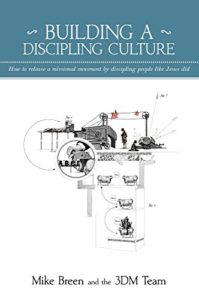
Date read: 04.27.2017. How strongly I recommend it: 7/10.
See my Kindle highlights here.
TARGET AUDIENCE
This book is unequivocally written for Christian leaders and laymen who recognize the appalling insouciance for discipleship in Western churches. These readers resonate with the author’s sentiment when he says, “The problem is that most of us have been educated and trained to build, serve and lead the organization of the church. Most of us have actually never been trained to make disciples.” Their mounting frustration at the sad fact that Jesus’ primary concern has been overlooked may have led them to this book and to the 3DM Network, which has seen a rekindling for disciple-making efforts in the Western world. Whatever the reader’s reason for exploring this book, he or she will be inspired (perhaps even awestruck) to find that discipleship is indeed possible in their church setting.
CONTENT QUALITY
I deliberated long and hard about an overall score for this book. Please take my score lightly. I wanted to love this book. I am convinced that the content in these pages holds a key that could unlock the way we think about and do discipleship in the Western context. In fact, the movement of 3DM has already been successful in this endeavor. But, alas, I felt that the book fell flat and bland. Still, I believe that there is a reason for this. “Building a Discipling Culture,” a friend who has participated in “huddles” for years, explained, “is the dictionary of the 3DM Network.” Should I desire an impassioned articulation about what the 3DM Network has accomplished, my friend suggested that I read the author’s book “Family on Mission” instead. This book, Building a Discipling Culture is the nuts and bolts—or more succinctly: the language—of this particular missional movement. There were, of course, inspirational nuggets to be mined from these pages: “Most of us have become quite good at the church thing. And yet, disciples are the only thing that Jesus cares about, and it’s the only number that Jesus is counting. Not our attendance or budget or buildings. He wants to know if we are ‘making disciples.'” Suffice to say that this book was not what I expected it to be. I take responsibility for this misunderstanding because of my lack of research. Perhaps, as my friend suggested, I should have begun with another book by the noble author.
MESSAGE CLARITY
The author’s message is crystal clear, desiring to empower church leaders and laymen to establish robust discipleship groups, or what he calls “huddles”. “Jesus’ model for seeing heaven colliding into earth,” says the author, “for seeing the Kingdom of God advance in community, for seeing the world put to rights and people becoming Christians, was discipleship. Period. That was his whole deal.” He not only admonishes Christian churches to embrace a culture of discipleship but also provides the nuts and bolts how to begin this process. This model, the author reiterates, has been time tested for over thirty years. Though the specific language of LifeShapes (see next section: “Creative Style”) might not appeal to everyone, I do believe that there is tremendous power in this method.
CREATIVE STYLE
“The language we use, called LifeShapes,” the author explains, “is a collection of eight shapes with each shape representing a foundational teaching of Jesus or principle from his life and is one that I (Mike) started developing in the early 1980’s.” These shapes, I believe, are the essence of the book’s creativity. The author is not particularly verbose or loquacious, and indeed this book needs not linguistic creativity as it acts as a manual for the discipleship process.
LANGUAGE SELECTION
This book’s creativity revolves around the “cultural language” of the 3DM Network, again, namely, LifeShapes. Though I have been part of discipleship movements in the Asian context for nearly two decades, I have personally never been involved in a “huddle” like the author explains. Again, the language is used by the author and the 3DM Network is quite unique and concentrated toward a Western reader who generally has little life experience in an intentional discipleship process. Speaking to a Western demographic, the author says, “Every disciple is missional. It’s part of the deal! Most of us simply don’t live that way.” This book challenges and provokes a response to Jesus’ “whole deal” of making disciples. Because “most of us have been trained and educated for a world that no longer exists,” I find that the strategies found in this book are relevant for the Western believer.
OVERALL IMPACT
So far, this review feels favorable and positive. To reiterate, I wholeheartedly believe that the content in this book will transform churches and individuals in tremendous ways. I have seen its outworking in the lives of friends and churches throughout America. But the overall impact for me was severely lackluster. The reason for this is because I have experienced relevant styles of discipleship in Asia for the last twenty years. I have witnessed healthy cell groups reproduce multiple times over, thus evangelizing the lost and planting flourishing churches. This book did not impact me as much as it might another because, though I am American, my worldview and mindset have shifted over the years of cross-cultural missionary service. I view the world through a different lens than most of my countrymen. That being said, I believe that new horizons will open to the general Western reader as they encounter practical strategies of relational discipleship that the author provides in this book.
10 POINT RATING
I give Building a Discipling Culture a 7/10.


